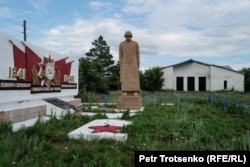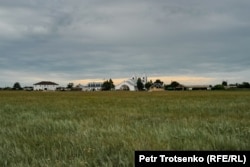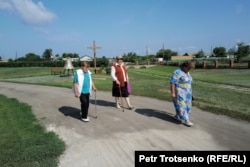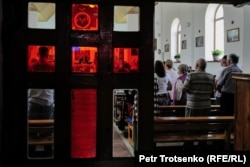OZERNOYE, Kazakhstan -- A small village amid the steppes of northern Kazakhstan has become an unlikely Catholic pilgrimage site where the Shrine of Our Lady of Peace -- the only Marian shrine in Central Asia -- is located.
Nestled between the cities of Petropavlovsk and Kokshetau, Ozernoye was founded nearly 90 years ago when Poles banished from Ukraine were resettled in Kazakhstan.
The first wave of mass deportations of Poles began in 1936, when the "Stalinist" constitution was adopted by the Soviet Union. Although the constitution proclaimed democratic freedoms, in practice a policy of political terror, mass repression, and expulsions was carried out.
On April 28, 1936, the Soviet government decreed the deportation of over 35,000 Poles from the Vinnytsia, Zhytomyr, Kyiv, and Kirovohrad regions of Ukraine to northern Kazakhstan.
The second wave of deportations in 1940-41 saw over 60,000 Poles sent to Kazakhstan from areas occupied by the Red Army during World War II, which later became western Belarus and Ukraine.
During the Soviet era, the collective farm in Ozernoye primarily grew wheat. Following the collapse of the Soviet Union, the farm closed, resulting in widespread unemployment and an exodus of residents.
The local school also shut its doors, forcing the few remaining schoolchildren to attend classes in nearby villages. Today, fewer than 200 people live in Ozernoye.
Despite its decline, Ozernoye remains a vibrant community due to its status as a significant pilgrimage site for Catholics from Kazakhstan and Poland.
A Miraculous Lake, An Altar, And A Pilgrimage Site
According to local legend, on March 25, 1941, when the exiled Poles were dying of hunger during the famine, they prayed to the Virgin Mary. Suddenly, the snow began to melt, and a sizable lake formed close to the settlement as the temperatures climbed.
The villagers were saved from starvation when an abundance of fish appeared and allowed them to survive.
In 1997, a statue of the Virgin Mary holding a fishing net full of fish was erected on the shore of Lake Mariyamkol in her honor. The statue was consecrated by Pope John Paul II before being sent to Kazakhstan. Today, the Marian shrine is the only one located in the entire Central Asian region, including Mongolia and Afghanistan.
The first Catholic church in Ozernoye was established in the early 1990s. A few years later, a large temple was built on the village's outskirts, where regular services and Christian holidays are celebrated.
In 2011, the parish in Ozernoye was officially declared a "national sanctuary of Our Lady Queen of Peace, patroness of Kazakhstan."
Every year, thousands of pilgrims visit the small village and help keep the connection between the descendants of the deported Poles and their historic homelands.
In 2013, the "Star of Kazakhstan" altar, designed by Polish artist Mariusz Drapikowski, was installed in the church. This altar, one of 12 worldwide, features a Kazakh ornament symbolizing the connection between the Catholic world and Kazakhstan. It was consecrated by Pope Benedict XVI.
Every year, thousands of pilgrims come to the village, bringing new life and allowing the exiled Poles to never forget their ancestral homeland. Several years ago, a three-story hotel was opened. At times, there are no vacancies.
Preserving History And Heritage
Recently, a group of Polish pilgrims visited Ozernoye to restore the cemetery, which was overgrown with bushes and weeds. The cemetery, with its aged tombstones and crooked crosses, serves as a stark reminder of the harsh conditions endured by the Poles and the tragically high child mortality rates.
Local elders, who know the stories from their parents, are often reluctant to discuss them with outsiders. One elderly man offered zucchinis to visitors instead of discussing his family's deportation -- such is the enduring pain that reverberates even today.
Following the death of Stalin in 1953, the Polish exiles were allowed some freedoms, but compensation for their lost properties was never offered.
Historians estimate that between 100,000 and 250,000 Poles were deported to Kazakhstan. According to the 1959 census, over 53,000 Poles were alive in Kazakhstan. Today, only 32,000 remain, mainly in the northern regions.
A Sense Of Belonging
In the evening, two elderly men were walking by and stopped to exchange pleasantries. They also opened up about their lives living amid the Kazakh steppes.
"I am 80 years old. I am a Pole, but I was not exiled. I came here from Ukraine with a Komsomol referral. I stayed in Kazakhstan. Though our village is disappearing, many of us [Poles] still live here," Ivan said.
Ivan also expressed mixed feelings about returning to Poland.
"There is nothing to do in Poland. My wife visited relatives there three or four times with our children, but they didn't like it," he said.
Karczynski, as he wished to be known, said he visited Poland once. It was nice to visit, he said, but he felt that home was still in Kazakhstan.
"It was nice visiting and staying in a hotel, but it's not home," he said. "After a few days, I missed Kazakhstan."
He added, "We do not forget that we are Poles. We speak Polish at home with my grandmother, and we communicate in Polish with our relatives.
On one Sunday, the church in Ozernoye was filled with parishioners, including Polish pilgrims and schoolchildren from the neighboring villages who were staying at the Catholic summer camps. Nestled among them were the elderly from the local population.
After the service, volunteers handed out chocolates at the exit of the church. As Karczynski and his wife slowly approached, the volunteers warmly embraced them -- in their native language.






















